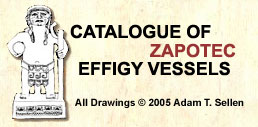| Key: SOLO 1 | | Actual Location: Unknown | | Collection: Fernando Sologuren #481 | | Provenance: Huitzo, Etla, Oaxaca. | | Measurements: 28 x 16.5 cm. | | Color: Dark brown. | | Chronology: Xoo 600 - 800 AD | | Click to view Chronology | | Reference: Drawing by Sabino Soriano in the unpublished work of Manuel Martínez Gracida, second volume "Wood Statues" 1910: plate 78; Peñafiel 1893: plate 23; Bauer's photo circa 1900, in König and Kröfges 2001: 131, S14. | | Comments: Wood effigy with bearded human figure. A human face sticking out of the mouth. This piece was described by Sologuren as "Wooden Idol" and by Peñafiel as "Wood Idol from Zompantle". According to the work of Martínez Gracida (1910) it represents "Pitao Cozaana" and he adds that the piece was found in the house of José Trápaga, in Huitzo, in 1890, who later gave it to Fernando Sologuren as a present. The same author also draws our attention to the fact that the piece looks old because it is badly gnawn by moths. | |
| | 
Click to view high resolution in a new window
select this image for review |
